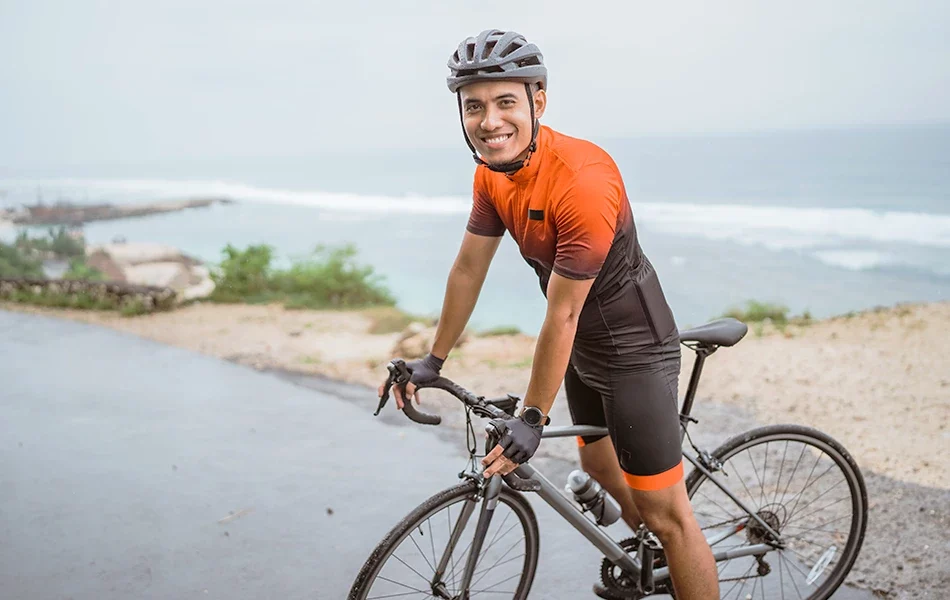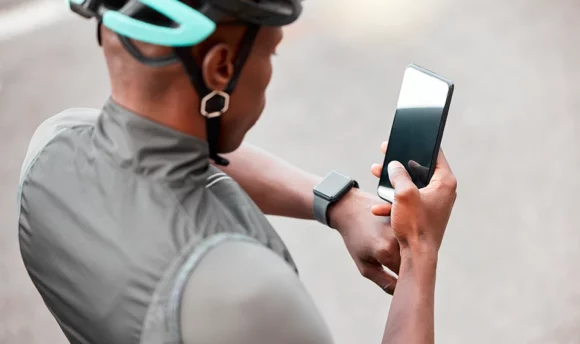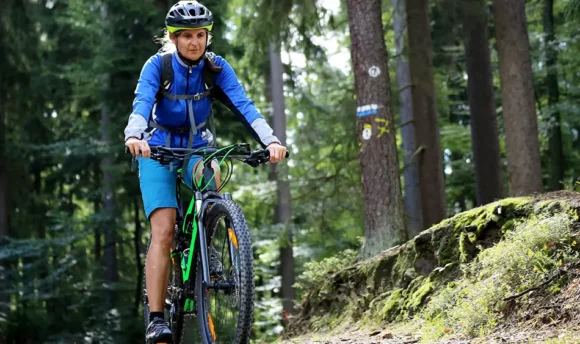How to Cycle Faster: 10 Expert Tips for a Speedy Ride
Whatever your goals, there are plenty of ways to boost your cycling speed. Discover the top techniques to elevate your average speed time on the road in this complete guide.

Anybody with a passion for cycling is keen to become a stronger cyclist. You might feel a strong drive to improve as you monitor your average speed over the weeks and months. It might be that you want to compete against others or prove a point to yourself.
How fast you move on a bike depends on things like the environment, your fitness level, and the bike itself. Once you understand these factors and their influence on your ride, you can make long-term changes that boost your cycling speed.
Here are 10 top tips to improve your average speed time for a faster, smoother ride.
How to Cycle Faster? 10 Tips From a Professional
Whether you’re preparing for a race or simply want to beat your average speed time, you can try a few things to accelerate cycling. Many factors can influence your overall speed, from the weather and location to the clothes you wear.
Try these 10 strategies and exceed your personal best.
#1 Build the strength in your quads
Your legs comprise your most important cycling muscles, and this includes your quads. The quads, or quadriceps, are a group of four muscles located at the front of your thighs. Your quads are the powerhouse behind pedaling, so building muscle in this area is crucial.
Strong quads give you the extra power to pedal faster for longer. Your body won’t tire as quickly with strong legs that can keep doing the hard work, allowing you to hit full speed.
Cycling will help strengthen your quad muscles, but you can further increase strength with training sessions and workouts that train them specifically. Try including squats, split squats, lunges, leg extensions, and leg presses in your routine to whip your quads into shape.
#2 Improve your core strength
A strong core is a must for improving your cycling speed. It helps you maintain stability while riding, ensuring you remain in the proper position and don’t sway from side to side. With a weak core, cyclists tend to waste energy trying to compensate for the job of the core muscles.
In addition, core strength helps ensure good form and reduce the risk of injury. You can train your core with exercises like the plank, side plank, bicycle crunch, and Russian twists. These workouts target the abdominal, lower back, hips, and oblique muscles.
#3 Know how to use energy efficiently
Using your energy efficiently will help you maximize your potential to achieve a higher average speed. If you do not manage your power output, you will use up your energy more quickly. This means that you’re putting in more effort than necessary to get a good pedal stroke.
You can use your energy more efficiently by considering when you pedal and brake. For example, don’t waste your energy pedaling faster before slamming the brakes on for a stop sign. Don’t hit your brakes without good reason, either, as you’ll use more power restarting.
#4 Find a group
Riding in a group of fellow cyclists is a good way to boost your average speed. Firstly, there’s the incentive to ride at the same speed as the other riders. It can increase your motivation, encouraging you to ride harder to keep up with the rest of the group.
Group riding can also decrease the aerodynamic drag and energy expenditure as cyclists traveling in a straight line, close behind one another, help cut through the wind. This allows you to cycle faster than you would alone with the same level of effort.
Furthermore, the social aspect of group cycling means you can learn a lot from other riders. It’s an excellent opportunity to discover tips and tricks from more experienced cyclists, and it might help you improve overall.
#5 Try interval training
You can’t just start riding faster. You have to build it up, and that’s why interval training is a great way to improve your speed. Interval training is when you alternate between periods of low- and high-intensity cycling.
It boosts your anaerobic capacity, strengthening your cardiovascular system and allowing your body to work harder and maintain the level of intensity for longer.
An example of a cycling interval session might involve quick bursts of pedaling faster and harder than your average speed before slowing down and riding easy for several sets.
#6 Brake less
It’s simple – braking slows you down. Once you slow down, you must pedal harder to build up your speed again. This demands more energy and can leave you tired, making it difficult to cycle at a consistent, increased speed.
There are times when you need to brake and times when you don’t. Many riders brake unnecessarily when they start to roll a little faster, such as when going downhill. However, this is the ideal time to maintain your pace and make the most of your free speed.
#7 Invest in aero clothing
Dressing appropriately is crucial to shaving off minutes from your next ride.
Beginners don’t always realize the importance of clothing, but the right clothes can make it easier to move faster through the wind with less effort. Aero clothing is beneficial because it’s snug, whereas loose, baggy clothing catches the wind and slows you down.
These cycling clothing items are typically made from Lycra and other body-hugging fabrics that reduce aerodynamic drag.
You can also purchase an aero helmet to combat wind resistance. It fulfills the same safety purpose as a standard helmet but with additional qualities to smooth airflow.
#8 Eat a nutritious diet
Eating a nutritious diet will fuel your bike rides. What you put into your body can significantly influence cycling performance. Studies recommend that competitive and recreational cyclists consume a balanced diet with enough calories to meet energy demands.
Dehydration and glycogen depletion can hinder endurance performance, making carbs and fluid intake essential. You also need good fats to fuel energy and protein for muscle recovery. Fill your diet with complex carbs, lean protein, and healthy mono and polyunsaturated fats.
A well-balanced diet also aids weight control. This is beneficial for those carrying excess weight, as losing weight makes you more aerodynamic and able to move at a faster pace.
#9 Maintain your bike
A healthy bike is better equipped for reaching higher speeds. It takes less effort to hit your average goal when everything works correctly. Additionally, riding a well-maintained bike can increase your confidence and support your performance as you tackle a challenging ride.
You should schedule regular services and DIY checks on your bike. Bike maintenance tips include cleaning, regular tire checks, inflating tires, checking your brakes, and lubricating the drivetrain.
Some bikes are more high maintenance than others. Those partaking in cross-country mountain biking may need to provide more care than those riding an average road bike.
#10 Think about upgrading your tires
Rolling resistance is the energy your bike needs to maintain travel at a consistent speed. The resistance slows you down and occurs primarily because the tire deforms as you move. Switching old, worn tires for new ones can increase your rolling resistance and speed things up.
Poor tires can slow you down. The width and tread substantially impact how much traction you have and how fast you can move. Investing in a set of high-quality bike tires is an excellent way to transform your speed and power.
What Is a Good Average Cycling Speed?
A good average speed for cyclists is hard to judge because it depends on the bike, the rider’s fitness level, and the terrain. Generally, maintaining an average speed in the mid-teens (around 15.5mph) for a prolonged period is good for a fit and competent cyclist.
Still, professional cyclists riding on flat terrain can reach higher speeds, anywhere between 25 and 28mph.
How to Get Better at Cycling?
There are many ways to boost your cycling ability. It won’t happen overnight, but you will soon notice positive changes with a consistent routine. Like anything, the more you do it, the easier it gets. You should cycle regularly while remaining mindful of how to prevent injuries.
Besides your rides, improving your overall fitness level to build strength and endurance pays off. You can do this with a training regimen that targets the lower body, including the core, quads, glutes, hamstrings, and calves – muscle groups that work the hardest during a bike ride.
Once you get more comfortable with cycling, you can gradually increase your speed and slowly build up your capacity for longer rides. You can focus on nutrition to fuel your energy levels, invest in the right cycling gear, and boost motivation with support from pro riders.
FAQs
The average cycling speed for a beginner is 12mph, 15–16mph for somebody with more experience, and 20–24mph for an avid rider. Most cyclists are happy to keep an average speed in the mid-teens.
Road bikes are faster than mountain bikes and can move at substantial speed. For example, the average road bike can hit an average speed between 14 and 18mph.
How fast a bike is depends on the model, as different bikes can travel at different speeds. It also depends on the rider, the terrain, and other riding conditions. Generally, a bike’s speed ranges anywhere from 10 to 30mph.
A Word From an MD
Cycling is one of the best sports because it has many benefits for the human body. It strengthens the muscles, supports the joints, improves heart health, and helps transform body shape. It aids weight loss, as a 30-minute session can burn around 200–700 calories.
You can ramp up your speed with greater body strength, good nutrition, and interval sessions. It can also help to modify your route based on the wind direction for an easier ride with less air resistance. Stay hydrated and consume a carb or protein-based meal or snack.
Conclusion
With a few good habits, you can quickly build confidence and go fast. Some you can practice today, while others can be introduced gradually. Building strength, eating right, dressing properly, and maintaining your bike are all essential to riding at high speeds.

















































 Select your language:
Select your language: 








